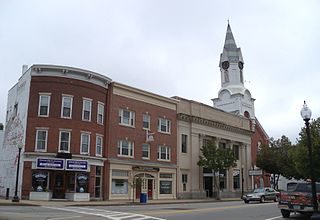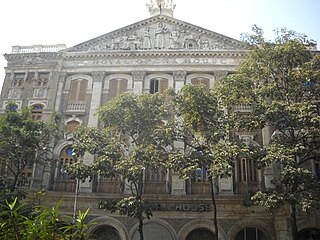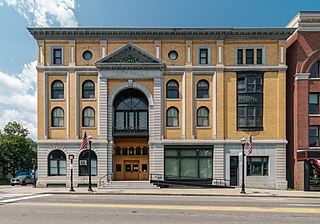
The Rochester Opera House is a 750-seat theater in the city hall of Rochester, a city in Strafford County, New Hampshire, United States. It has the unique architectural feature of a fully moveable floor, perhaps the last of this design in existence.

The Rochester Opera House is a 750-seat theater in the city hall of Rochester, a city in Strafford County, New Hampshire, United States. It has the unique architectural feature of a fully moveable floor, perhaps the last of this design in existence.
The Rochester Opera House was built in 1908, designed by George G. Adams. Adams built six other municipal buildings for cities around New England, including Waterville, Maine, Dover, New Hampshire, and Derry, New Hampshire. Construction costing nearly $62,000, the Rochester Opera House accommodated 1,012 people and featured a grand proscenium, intricate stenciling, murals, and a suspended horseshoe balcony. One of its most interesting features was its unique moving floor system. The floor of the opera house can be lowered to become a flat surface and be used for dances, town hall meetings, etc. or raised to a tilt for viewing shows. Adams equipped four different buildings with this flooring system. However, due to fires and other events, the Rochester Opera House is the only known theater in the United States to still use this type of flooring. It is truly an architectural treasure. [1]
Like most buildings, over time the Rochester Opera House started to deteriorate. Restoration plans for the opera house started in the mid 1980s fronted by the Rochester Heritage Trust and the Arts Rochester Organization. [2] An early challenge facing these groups was to uncover and fully appreciate the mechanics present in the unique floor-moving system. Understanding such complexities was aided considerably by an extensive study finished in June 1985 by Nancy Alberto and Heidi Barrett, students of the Department of Civil Engineering at the nearby University of New Hampshire. Estimates for restoring the opera house and also establishing an endowment fund for maintenance and program scheduling ranged up to $1.2 million. Due to the enormity of the task and the size of the necessary costs, the first effort to restore the opera house only accomplished improvements to meet fire and safety codes, as well as much-needed audience amenities.
It took more than a decade for another attempt to be made to restore the opera house. In 1996, after Mayor Harvey Bernier Jr. took office, restoration continued. [3] [4] Restoration focused mostly on bringing the unique flooring back to working condition, restoring the original stenciling, and bringing the opera house back to its original state. After only an impressive eighteen months, with over $300,000 of donated money and goods (above what the city had already agreed to pay), and ten thousand hours of volunteer labor, the Rochester Opera House restoration was completed. Following nearly a quarter century of dormancy, the opera house reopened its doors to the public in 1997. [5] [6]

The Rochester Opera House is a very important architectural and historical building. While also housing the city hall, it has been a vital part of most all the important historical moments in Rochester, New Hampshire. To this day, it is still a center for politics and entertainment in the community.
As well as being an important building for entertainment in Rochester, the Rochester Opera House is a hub for political activity in the city. The opera house has hosted speeches by numerous politicians and famous individuals including Pete Buttigieg, Barack Obama, [7] John McCain, [8] Bill and Hillary Clinton, [9] and Donald Trump. [10]
After celebrating its 100th anniversary in 2008, the Rochester Opera House is still in operation today. Restored to look like it did over ninety years ago, the opera house offers the visitor a unique viewing experience.

Rochester is a city in Strafford County, New Hampshire, United States. The population was 32,492 at the 2020 census, making it the 6th most populous city in New Hampshire. In addition to the downtown area, the city contains the villages of East Rochester, Gonic, and North Rochester. Rochester is home to Skyhaven Airport and part of Baxter Lake.

Somersworth is a city in Strafford County, New Hampshire, United States. The population was 11,855 at the 2020 census. Somersworth has the smallest area and third-lowest population of New Hampshire's 13 cities.

A ballroom or ballhall is a large room inside a building, the primary purpose of which is holding large formal parties called balls. Traditionally, most balls were held in private residences; many mansions and palaces, especially historic mansions and palaces, contain one or more ballrooms. In other large houses, a large room such as the main drawing room, long gallery, or hall may double as a ballroom, but a good ballroom should have the right type of flooring, such as hardwood flooring or stone flooring .. For most styles of modern dance, a wooden sprung floor offers the best surface.

The Woodstock Opera House is a historical venue for performing arts and receptions located in Woodstock, Illinois. It was built in 1889 and designed as a multi-use facility with space for city administration offices as well as police and fire departments. The building was planned by architect Smith Hoag and built by contractor Simon Brink for a cost of $25,000. Today, the City of Woodstock still owns the building, but the building is used exclusively as a performance space.

Chicago College of Performing Arts is a performing arts college that is housed at Roosevelt University in Chicago, Illinois, United States.

The 2006 House of Representatives elections in New Hampshire took place on November 7, 2006 to determine who would represent the state of New Hampshire in the United States House of Representatives during the 110th Congress from January 3, 2007 until January 3, 2009.

Sandwich City Hall, which is also known as the Sandwich City Hall & Opera House, is the government center for the city of Sandwich, Illinois, in DeKalb County. The first floor of the building is occupied by city government while the second floor of the historic building houses an active opera house. Sandwich City Hall & Opera House is listed on the National Register of Historic Places and has been since 1979.

Royal Opera House, more commonly known simply as Opera House in Mumbai, is India's only surviving opera house.
Joseph D. "Joe" Kenney is an American politician and member of the Republican Party who represented District 1 of the Executive Council of New Hampshire from 2014 to 2019. He previously served as a member of the New Hampshire Senate, representing the 3rd District from 2003 to 2009, and as a member of the New Hampshire House of Representatives from 1995 until 2003.

The 1905 Mary W. Adams House, is a Frank Lloyd Wright designed Prairie School home that was constructed in Highland Park, Illinois. The Adams House is a two-story home with three bedrooms and two bathrooms with a light stucco exterior and wooden trim that emphasizes the horizontal.

Claremont City Hall, also known as the Claremont Opera House, is located at 58 Opera House Square in the heart of Claremont, New Hampshire, United States.

BiddefordCity Theater is a year-round near 500-seat, restored Victorian opera house at 205 Main Street in Biddeford, Maine, United States. Biddeford City Theater is a non-profit, volunteer-driven, organization that produces and hosts plays, musicals, concerts, movies, music, comedy, and other artistic performances with patrons from all over New England. The mission of City Theater Associates is to foster an appreciation for the performing arts by using creative avenues to increase community involvement.

Hudson Hall at the historic Hudson Opera House is an arts organization and venue in downtown Hudson, New York. The organization presents and produces arts and cultural programming year-round, and is an important civic partner in the vitality of Hudson. The building, constructed in 1855 as Hudson's city hall, is New York's oldest surviving theater.

The Howell Opera House is an opera house located in Howell, Michigan. The site is listed as historic by The Michigan State Historic Preservation Office. It is also listed on The National Historic Register as part of the Howell Downtown Historic District.

The McHaffey Opera House is a historic building located in Eldon, Iowa, United States. It was constructed in 1891 and in use by the community through the 1940s. The building was mainly unused for many decades until a volunteer community group bought the opera house in 1995 and began restoration efforts. The McHaffey Opera House was placed on the National Register of Historic Places in November, 1995.

The Deerfield Town House is the town hall of Deerfield, New Hampshire. Built in 1856, it is one of the state's finest examples of public Greek Revival architecture. The building was listed on the National Register of Historic Places in 1980, as "Town House".

George G. Adams was an American architect from Lawrence, Massachusetts.

Barre City Hall and Opera House is a historic government building at 6 North Main Street in downtown Barre, Vermont. Built in 1899, it houses the city offices, and its upper floors have served for much of the time since its construction as a performing arts venue. The building was listed on the National Register of Historic Places in 1973.

White Eagle Hall is a music, theatre, and dining venue in a restored historic building in the Village neighborhood of Downtown Jersey City, New Jersey, located on Newark Avenue. Originally built in 1910 as community center. It was used for events such as bingo games, dance recitals, and concerts, and later as a basketball practice hall. It has been restored as a performing arts, gallery space, and restaurant complex.

New South Wales Club building is a heritage-listed former clubhouse and now offices located at 31 Bligh Street, in the Sydney central business district, in the City of Sydney local government area of New South Wales, Australia. It was designed by William Wardell and built from 1886 to 1887 by John Try. It housed the New South Wales Club from 1886 until the club's amalgamation with the Australian Club in 1969. It was then sold and the two rear wings demolished in 1973 before the surviving front portion was converted to offices. It was added to the New South Wales State Heritage Register on 2 April 1999.